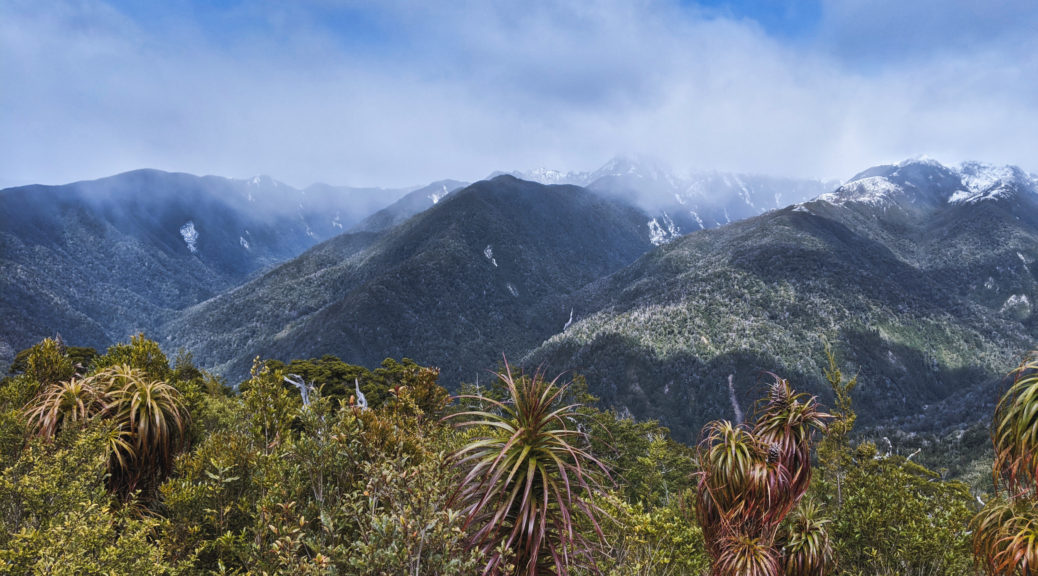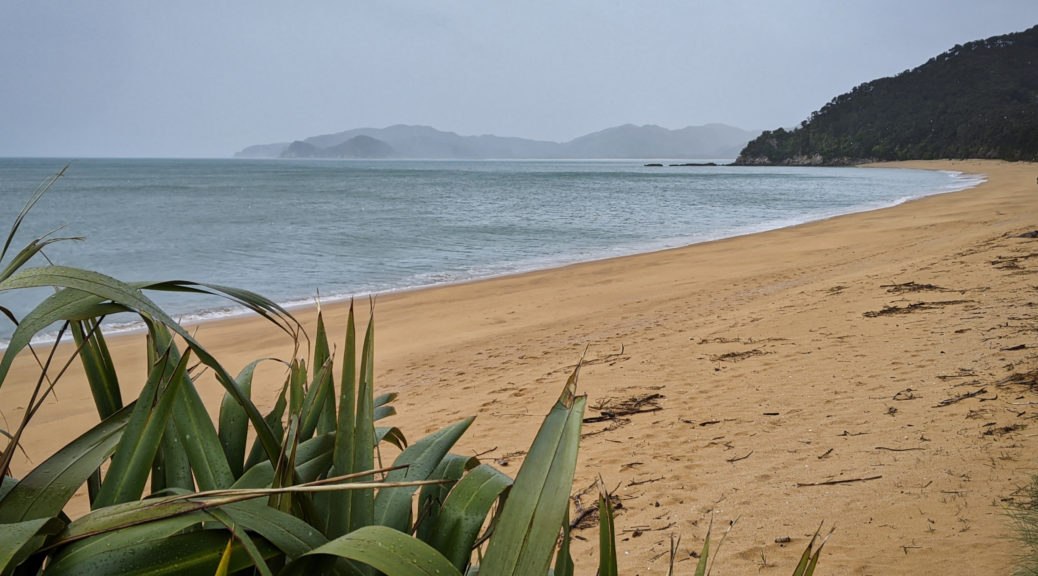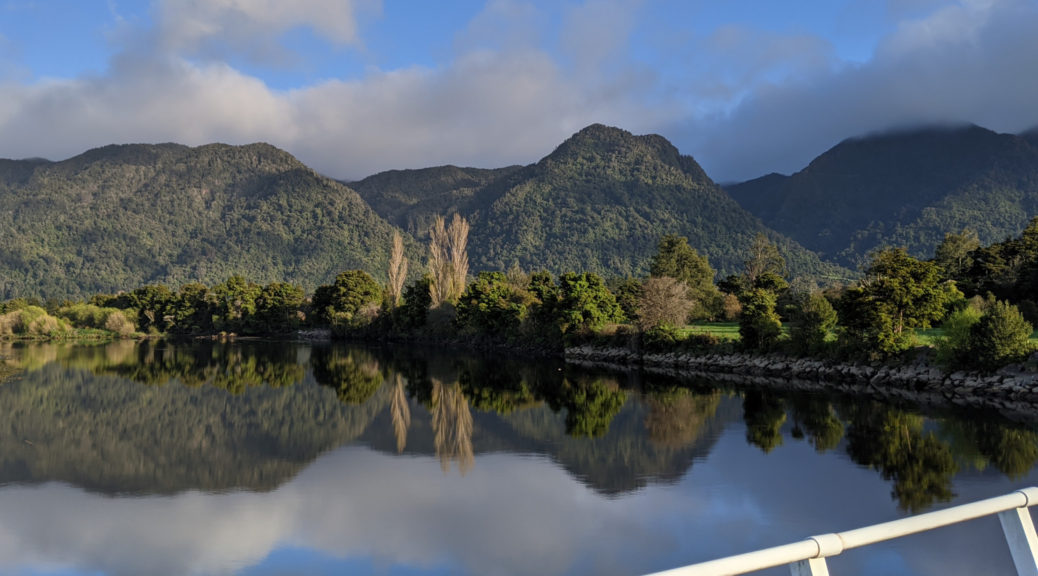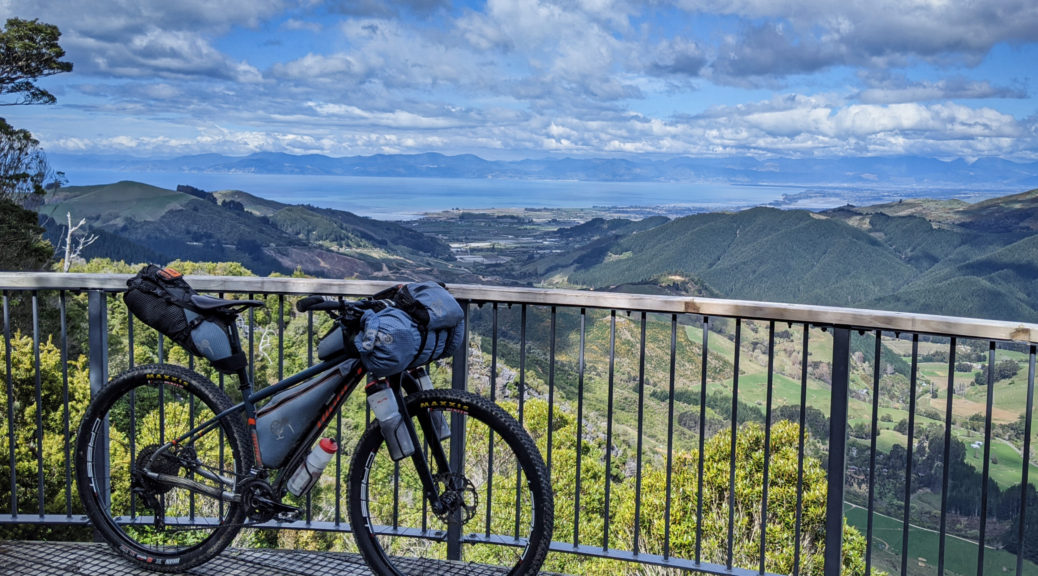Twas worth waiting for the weather, leaving the campground in the dark a cracker of a day dawned. Using the Heaphy Track as my gateway to the West Coast, I hoped to ride to and through it in the day. First there was fifty-odd kilometres of gentle road riding, but the big question was how much snow would be on the track? With a biking curfew during darkness (due to giant land snails, I kid you not), would I get off the track in time or be forced to overnight in a hut or campground? With form of riding the whole trail there and back in two short days around winter solstice, I figured I could easily start at nine in the morning and ride through in daylight – if the snow was kind.

The highway riding was peaceful and a gentle start to the day. Delayed as I couldn’t go past someone parked on a sketchy shoulder struggling to change a car tyre, I started to slip behind the vague schedule. But it was so lovely riding, there were no worries there.
 Turning inland, I retraced my path back from the third corner trying to gauge just how much snow remained below 900 m. It was far more pleasant than the driving rain of three days before.
Turning inland, I retraced my path back from the third corner trying to gauge just how much snow remained below 900 m. It was far more pleasant than the driving rain of three days before.
I took the gravel option over Mackay Pass that I’d skipped on the weekend (knowing I would come back for it) – it was worth the little extra climbing. Of course I had time to dive off route and check out a historic bridge and some falls – when was I going to be back?


I shouldn’t have been surprised to see another bikepacker approach as I neared Brown Hut and the start of the track. Into the only real climb of the day, I soon passed another bikepacker going my way – on a tour the length of the country, he was far more laden than most but having just as grand a time. Occasional glimpses through the dense bush afforded views of near hills lightly dusted with snow. At about 500 m snow started appearing trailside and as it gradually built, it was still easily rideable – until 800 m and then it just became easier to walk. Firm and dry it was really easy pushing over the snow, and on such a brilliant day it was no hardship.



 A short walk for another view.
A short walk for another view.

 I already miss being able to fill bottles from the multitudes of clean West Coast streams.
I already miss being able to fill bottles from the multitudes of clean West Coast streams.
Reaching the high point took two and a half hours; with gravity to assist, the run down to Perry Saddle hut was easily rideable. Following lunch in snowy solitude, the descent towards Gouland Downs was fun in the snow. More exposed to the sun here, it certainly was a soaking section. More engaging riding followed, especially the drop towards Gouland Hut, where I eventually caught up to a few groups of hikers soaking up the sun over lunch. More friendly chat before I pressed on.


Saxon Hut and more hikers to chat to, including one with a thirty-plus year old macpac pack – classic. Great to see so many families out in the school holidays enjoying the national park. Twists and turns and a smaller climb took me to James MacKay hut; even more pleasing to see a whole family out bikepacking. Oh my, the descent to Lewis Hut.. Three-quarters of an hour of twisting and turning losing altitude the whole time (save any stream crossings), the track is much improved from the big upgrade that was in progress five years ago. I clawed back some distance in short time with the big drop to sea level, various averages playing through my head – I was still confident I’d beat the curfew.

Into the coastal section, the change from snowy bush to riding through a sub-tropical rainforest was complete. Sea level it may have been, but it certainly was lumpy as the trail kept climbing around small bluffs and heading inland and up to cross raging streams. Getting to the end of a long day, all those little pinches were doing a number on me. But, the views!


 One last hundred metre climb and down to the trailhead it was – leaving these views behind.
One last hundred metre climb and down to the trailhead it was – leaving these views behind.
Beating darkness by almost two hours meant the pub was still pretty full and the kitchen open when I arrived an hour later. Well fed, I set off into the gathering dark to be warmly welcomed by Mark and Jenny – good friends of my sister. Running out of superlatives for the day, saying I thoroughly enjoyed the ride, the scenery and the challenge of it will have to suffice. It would have been nice to have had more time to explore further and more slowly, but a lot of the slack in my two weeks had been eaten up. Never mind, more reasons to return sooner.


 It looks nice, shortly after I was blown across a lane of traffic battling through a wind-funnel of a cutting.
It looks nice, shortly after I was blown across a lane of traffic battling through a wind-funnel of a cutting. Down to Ligar Bay from Abel Tasman monument.
Down to Ligar Bay from Abel Tasman monument.

 Wainui Inlet
Wainui Inlet


 Arriving at quarter to six, I was starting to get concerned I’d not correctly found the village square.
Arriving at quarter to six, I was starting to get concerned I’d not correctly found the village square. Past Collingwood, I was tiring of the flat seal – why weren’t we going up that bulldozer track?
Past Collingwood, I was tiring of the flat seal – why weren’t we going up that bulldozer track? Certainly wasn’t any wind about yet!
Certainly wasn’t any wind about yet! Huzzah, some gravel and a little climbing.
Huzzah, some gravel and a little climbing. Surprisingly still here, I enjoyed the ride back chatting to a local about his experiences televising big international cricket matches.
Surprisingly still here, I enjoyed the ride back chatting to a local about his experiences televising big international cricket matches. Stopping here was a cue for the heavens to open for ten minutes.
Stopping here was a cue for the heavens to open for ten minutes. By the time I got up here, the rain gear had to go.
By the time I got up here, the rain gear had to go. The Tasman Sea is just behind those hills, as my route continued left.
The Tasman Sea is just behind those hills, as my route continued left.
 That’s Corner Two, just out of shot a rather makeshift campground filled with hunting, fishing and whitebaiting types.
That’s Corner Two, just out of shot a rather makeshift campground filled with hunting, fishing and whitebaiting types. Retracing my tyre tracks was not as unpleasant as it might have been – it gave an opportunity to see somewhere I’d, until very recently, never been from a different angle.
Retracing my tyre tracks was not as unpleasant as it might have been – it gave an opportunity to see somewhere I’d, until very recently, never been from a different angle. This place wasn’t open late on a Saturday afternoon, more’s the pity.
This place wasn’t open late on a Saturday afternoon, more’s the pity.


 After a few spits of rain, the day cleared nicely.
After a few spits of rain, the day cleared nicely. Almost at the top of the road, a short side trip for the view.
Almost at the top of the road, a short side trip for the view. Yup, the hills certainly climb away from the coast very quickly.
Yup, the hills certainly climb away from the coast very quickly.